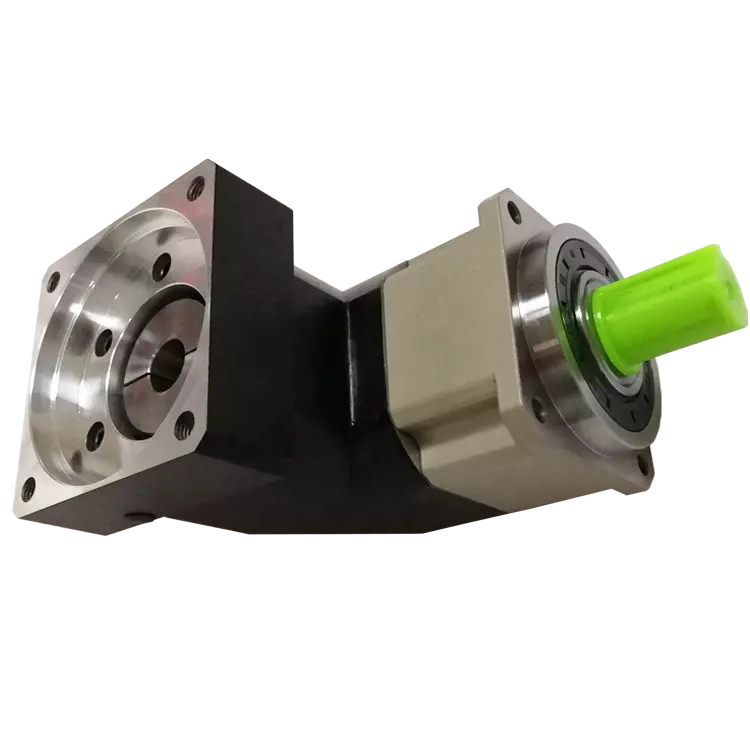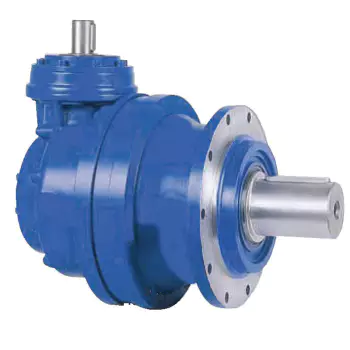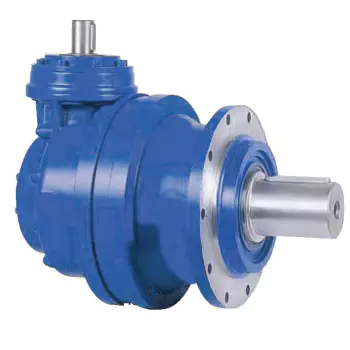Product Description
Product Description
NBR series adopts an integrated design of sun gear and input shaft, integrated design of output structure, and increased right-angle design for more flexible installation and space-saving. The product has the characteristics of high load, high precision, and low noise, focusing on the use of automation equipment, various types of packaging, printing, lithium-ion, LCD, robot, palletizers, woodworking, doors, windows, and other industry sectors.
Product Name: High Precision Planetary Gearbox
Product Series: NBR Series
Product features: high precision, high load, low noise, high flexibility, space saving.
Product Description:
Integrated design concept with high strength bearings ensure the product itself is durable and efficient
A variety of output ideas such as shaft output, flange and gear are available.
1 arc minute ≤ backlash ≤ 3 arc minutes
Reduction ratios ranging from 3 to 100
Frame design: increases torque and optimises power transmission
Optimised selection of oil seals: reduces friction and laminate transmission efficiency
Protection class IP65
Warranty: 2 years
Our Advantages
Advantages:
High precision
High load
Low noise
High flexibility
Space saving
Detailed Photos
Product Parameters
| Segment number | Double segment | ||||||||||||||||
| Ratio | i | 25 | 30 | 35 | 40 | 45 | 50 | 60 | 70 | 80 | 90 | 100 | 120 | 140 | 160 | 180 | 200 |
| Rated output torque | Nm | 610 | 570 | 520 | 470 | 420 | 610 | 570 | 520 | 470 | 420 | 420 | 570 | 520 | 520 | 420 | 420 |
| Emergency stop torque | Nm | Three times of Maximum Output Torque | |||||||||||||||
| Rated input speed | Rpm | 3000 | |||||||||||||||
| Max input speed | Rpm | 6000 | |||||||||||||||
| Ultraprecise backlash | arcmin | ≤4 | |||||||||||||||
| Precision backlash | arcmin | ≤7 | |||||||||||||||
| Standard backlash | arcmin | ≤9 | |||||||||||||||
| Torsional rigidity | Nm/arcmin | 50 | |||||||||||||||
| Max.bending moment | Nm | 9400 | |||||||||||||||
| Max.axial force | N | 4700 | |||||||||||||||
| Service life | hr | 20000(10000 under continuous operation) | |||||||||||||||
| Efficiency | % | ≥92% | |||||||||||||||
| Weight | kg | 27.5 | |||||||||||||||
| Operating Temperature | ºC | -10ºC~+90ºC | |||||||||||||||
| Lubrication | Synthetic grease | ||||||||||||||||
| Protection class | IP64 | ||||||||||||||||
| Mounting Position | All directions | ||||||||||||||||
| Noise level(N1=3000rpm,non-loaded) | dB(A) | ≤70 | |||||||||||||||
| Rotary inertia | Kg·cm² | 6.84 | 6.25 | ||||||||||||||
Applicable Industries
Packaging Machinery Mechanical Hand Textile Machinery
Non Standard automation Machine Tool Printing Equipment
Certifications
Company Profile
DESBOER (HangZhou) Transmission Technology Co., Ltd. is a subsidiary of DESBOER (China), which is committed to the design, development, customized production and sales of high precision planetary reducer as 1 of the technology company. Our company has over 10 years of design, production and sales experience, the main products are the high precision planetary reducer, gear, rack, etc., with high quality, short delivery period, high cost performance and other advantages to better serve the demand of global customers. It is worth noting that we remove the intermediate link sale from the factory directly to customers, so that you can get the most ideal price and also get our best quality service simultaneously.
About Research
In order to strengthen the advantages of products in the international market, the head company in Kyoto, Japan to established KABUSHIKIKAISYA KYOEKI, mainly engaged in the development of DESBOER high precision planetary reducer, high precision of transmission components such as the development work, to provide the most advanced design technology and the most high-quality products for the international market.
/* January 22, 2571 19:08:37 */!function(){function s(e,r){var a,o={};try{e&&e.split(“,”).forEach(function(e,t){e&&(a=e.match(/(.*?):(.*)$/))&&1
| Application: | Motor, Electric Cars, Motorcycle, Machinery, Marine, Toy, Agricultural Machinery, Car, CNC Machine |
|---|---|
| Function: | Distribution Power, Clutch, Change Drive Torque, Speed Changing, Speed Reduction, Speed Increase |
| Layout: | Plantery Type |
| Hardness: | Hardened Tooth Surface |
| Installation: | All Directions |
| Step: | Double-Step |
| Customization: |
Available
| Customized Request |
|---|

Disadvantages and Limitations of Angle Gearbox Systems
While angle gearbox systems offer numerous advantages, there are also some disadvantages and limitations to consider:
- Complex Design: Angle gearboxes can have a more complex design compared to standard gearboxes, which can make them harder to manufacture, assemble, and maintain. This complexity can also lead to higher production costs.
- Efficiency Loss: Due to the multiple gear stages and changes in direction of motion, angle gearboxes can experience higher friction and efficiency losses compared to straight-line gearboxes. This can result in some energy loss and heat generation.
- Space Constraints: The design of angle gearboxes often requires more space to accommodate the multiple gear stages and components, which can be a limitation in applications with limited space.
- Increased Maintenance: The complex design of angle gearboxes can lead to increased maintenance requirements. Components such as bearings, seals, and gears may need more frequent inspections and replacements.
- Cost: Angle gearboxes can be more expensive to produce and maintain due to their intricate design and the precision required in manufacturing. This can impact the overall cost of the machinery or equipment in which they are used.
Despite these limitations, angle gearbox systems are chosen when their benefits outweigh their drawbacks for specific applications. Engineers and designers carefully assess the requirements of the application to determine if an angle gearbox is the optimal solution, taking into account factors such as space availability, load demands, efficiency considerations, and budget constraints.

Impact of Gear Ratios on Performance of Angle Gearboxes
Gear ratios play a significant role in determining the performance of angle gearboxes. The gear ratio is a measure of how many revolutions the input shaft makes compared to the output shaft. Here’s how gear ratios impact the performance:
Torque and Speed Relationship: The gear ratio directly affects the relationship between torque and speed. In an angle gearbox, a higher gear ratio (such as 1:5) means that the output shaft will rotate fewer times than the input shaft but with greater force. Conversely, a lower gear ratio (such as 5:1) results in the output shaft spinning more times but with less force. This relationship is crucial for adapting the gearbox to specific application requirements.
Power Transmission: The right choice of gear ratio ensures efficient power transmission. If a high torque is required, a lower gear ratio is chosen to provide mechanical advantage. On the other hand, a higher gear ratio is selected for applications where higher rotational speed is essential. The gear ratio determines how effectively the gearbox can convert input power into the desired output power.
Application Adaptation: Gear ratios allow angle gearboxes to adapt to various applications. Different tasks require different combinations of torque and speed. By selecting the appropriate gear ratio, the gearbox can tailor its output to suit the specific demands of the task, optimizing efficiency and performance.
Overall, gear ratios in angle gearboxes provide a way to fine-tune the output characteristics, allowing them to fulfill a wide range of mechanical requirements across different industries and applications.

Types of Angle Gearboxes and Their Functions
Angle gearboxes, also known as bevel gearboxes, come in different types, each designed for specific functions and applications. The various types of angle gearboxes include:
- Straight Bevel Gearbox: This type of angle gearbox features straight-cut bevel gears with intersecting shafts set at a 90-degree angle. It is commonly used for changing the direction of rotational motion in applications such as automotive differentials and power tools.
- Spiral Bevel Gearbox: Spiral bevel gearboxes utilize spiral-cut bevel gears that offer smoother and quieter operation compared to straight-cut gears. They are employed in applications where reduced noise and improved load-carrying capacity are important, such as in heavy machinery and vehicles.
- Skew Bevel Gearbox: Skew bevel gearboxes have shafts set at an angle other than 90 degrees. They are used in applications where the intersecting shafts do not align at a right angle. Skew bevel gears are often found in industrial machinery and equipment that requires a specific angle of transmission.
- Hypoid Gearbox: Hypoid gearboxes feature hypoid gears, which are a variation of bevel gears with offset axes. This design allows the gears to mesh smoothly while reducing noise and increasing torque transmission efficiency. Hypoid gearboxes are commonly used in automotive applications like rear-wheel-drive systems.
- Angular Bevel Gearbox: Angular bevel gearboxes are designed for applications where the angle between the input and output shafts is adjustable. They are used in situations where the desired transmission angle can be changed to achieve specific mechanical requirements.
Each type of angle gearbox serves a distinct purpose, catering to various industries and applications. Their designs are optimized to provide efficient motion transmission, reliable performance, and the ability to accommodate different angles and loads.


editor by CX 2024-04-12
